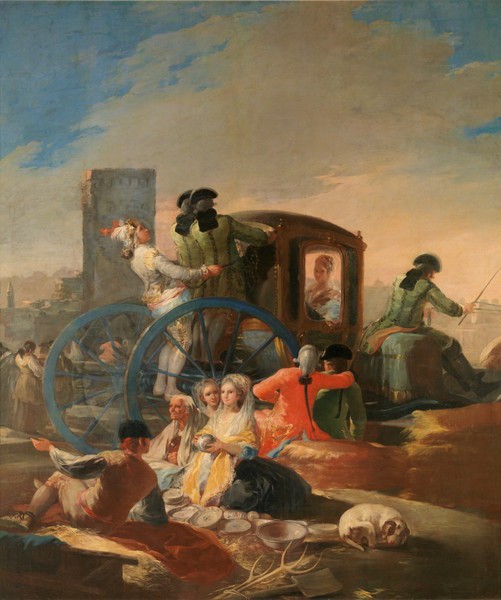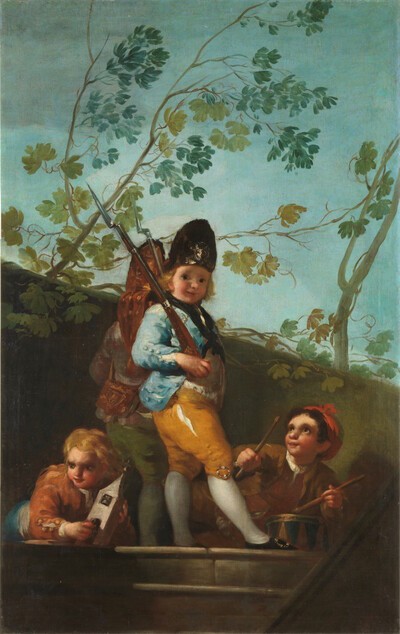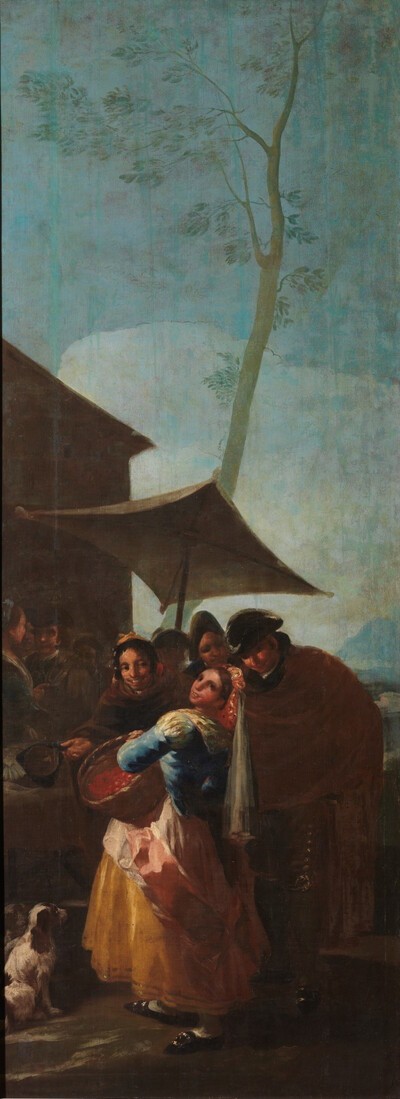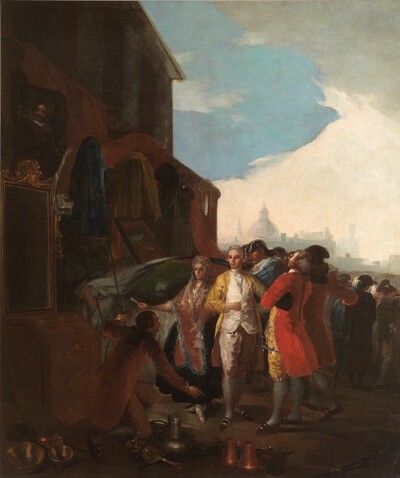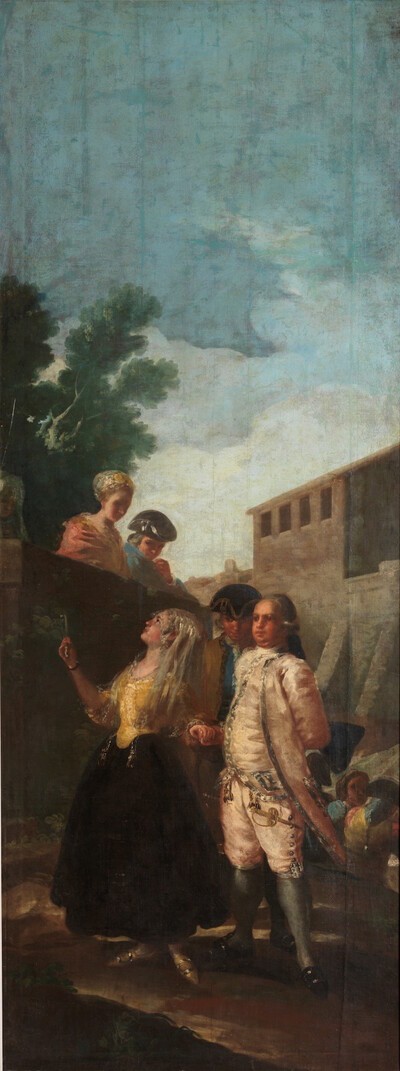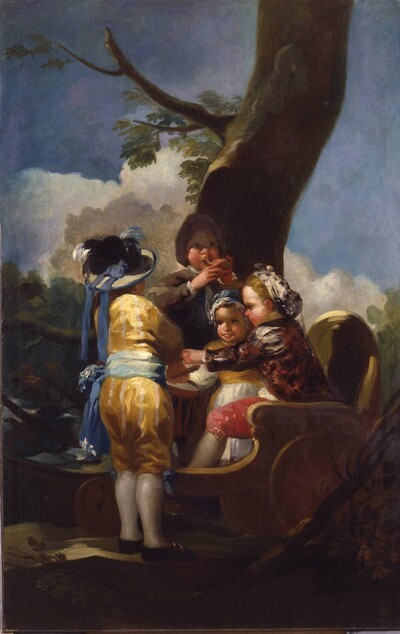- Cronología
- 1779
- Ubicación
- The Prado National Museum. Madrid, Madrid, Spain
- Dimensiones
- 259 x 220 cm
- Técnica y soporte
- Oil on canvas
- Reconocimiento de la autoría de Goya
- Documented work
- Titular
- El Prado National Museum
- Ficha: realización/revisión
- 22 Nov 2009 / 14 Jun 2023
- Inventario
- (P00780)
See The Fair at Madrid.
The tapestry of this cartoon would have hung on the west wall of the royal bedroom, opposite its companion piece, The Fair at Madrid.
In the foreground we see a group of women buying wares from the pottery vendor, who has been carefully rendered against the light. Behind them, a carriage is crossing the street, with a lady inside and her footmen holding on to the rear. In the image, the static quality of the first group contrasts with the dynamism of the second, accentuated by the movement of the page who appears to be bent backwards by the speed of the carriage. Camón Aznar sees in this visual contrast something more profound: the difference between two worlds - that of the common people and that of the lords and the nobility.
The world of the nobility is embodied in the portrait of the lady, who turns her melancholic gaze outwards towards the viewer from inside her richly-decorated carriage, whilst she is in turn observed by two gentlemen outside. The woman, who is depicted using a looser technique, is framed by the window and becomes the object of admiration of the two men. It has been suggested that this is the same woman who appears in the painting being scrutinized by the connoisseur in the companion cartoon, The Fair at Madrid.
Of special interest is Goya's skill in depicting still lifes, as can be seen in the crockery laid out on the ground and being handled by the women. Among the items, some Alcora ceramic pieces have been identified, coveted at the time as objects of luxury.
The expressiveness of the faces stands out here, especially that of the old woman accompanying the young lady, recalling the witches that Goya would later come to paint.
It is easy to see where the artist changed his mind about the position of the carriage wheel, which he ended up moving to the left. This was probably due to a lack of space, since even after the modification the composition ends somewhat abruptly at the coachman's feet, whilst the only visible sign of the horses are the hindquarters of one of the animals.
The reddish preparation that Goya applied, sometimes covered with a thin glaze, has caused the work to darken over the years. Its colours now appear flat and lack the tonal range that they would have had originally.
-
Les chefs-d’œuvre du Musée du PradoMusée d’Art et d’HistoireGeneva1939consultant editors Fernando Álvarez de Sotomayor y Pedro Muguruza Otaño. From June to September 1939cat. 38
-
El arte de GoyaMuseo de Arte Occidental de TokioTokyo1971from 16th 1971 to January 23th 1972. Exhibited also at the Kyoto Municipal Museum of Art, January 29th to March 15th 1972.cat. 9
-
Goya. 250 AniversarioMuseo Nacional del PradoMadrid1996consultant editor Juan J. Luna. From March 29th to June 2nd 1996cat. 19
-
Goya: Prophet der ModerneAlte NationalgalerieBerlin2005from July 13th to October 3th 2005. Exhibitied also at the Kunsthistorischemuseum, Vienna, October 18th 2005 to January 8th 2006, consultant editor Manuela B. Mena Marquéscat. 4
-
Goya en Madrid. Cartones para tapices 1775-1794Museo Nacional del PradoMadrid2014p. 141
-
GoyaBasle2021p. 81
-
L'œuvre peint de Goya. 4 volsParís1928-1950vol. I, p. 72, cat. 13
-
Tapices de GoyaMadridPatrimonio Nacional1946pp. 110, 222, cat. 22 y láms. 98-103
-
Vie et ouvre de Francisco de GoyaParísOffice du livre1970pp. 76, 88, cat. 125
-
BarcelonaPolígrafa1970vol. I, pp. 42, 247, cat. 75
-
L’opera pittorica completa di GoyaMilanRizzoli1974pp. 94, 95, cat. 82 y lám. III
-
Francisco de Goya, 4 vols.ZaragozaCaja de Ahorros de Zaragoza, Aragón y Rioja1980-1982vol. I, pp. 97-98 y p. 148 (il.)
-
Imagen de GoyaMadridLumen1983pp. 70-72
-
Francisco de Goya, cartones y tapicescol. col. "Espasa Arte"Espasa Calpe1987pp. 93, 95-97, 265, cat. 26C y pp. 96, 9
-
Francisco de Goya. Los cartones para tapices y los comienzos de su carrera en la corte de Madridcol. col. "Ensayos de Arte Cátedra"MadridCátedra1987pp. 106-109 y p. 101 (il.)
-
Goya. 250 AniversarioMadridMuseo del Prado1996pp. 300-301, cat. 19 y pp. 91-93 (ils.)
-
Salas del Palacio Real de El Pardo para las que se tejieron tapices sobre cartones de Francisco de Goya: identificación de las habitaciones y ajuste de las obras de Goya en los alzados de las paredesin HERRERO CARRETERO, Concha (curator, Tapices y cartones de Goya (catalogue of the exhibition organizated at the Palacio Real de Madrid, from may to june 1996)MadridPatrimonio Nacional, Goya 96, Lunwerg1996p. 170 (il.)
-
Goya en Madrid. Cartones para tapices 1775-1794MadridMuseo Nacional del Prado2014pp. 22-24, p. 141
